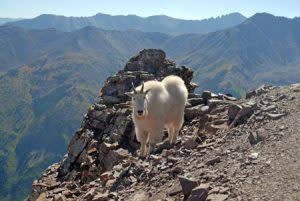
Big Sky Wildlife Spotlight: Mountain Goats
Mountain goats are natural mountaineers and may be considered the world's best climbers. They can often be spotted in high alpine terrain clinging to steep and rocky terrain features. It's a good idea to carry your binoculars on your hike or summit if you want to get a good look at a mountain goat. These surefooted and agile creatures are most at home on rocky ridges, precipitous cliffs, and high alpine tundra. They make climbing look easy!
Here are a few fun and interesting facts about mountain goats to share with your friends:
- The mountain goat's scientific name is Oreamnos americanus.
- Mountain goats are not goats. They are more related to antelope and are part of the bovidae family.
- These mammals are herbivores and eat grasses, herbs, sedges, ferns, mosses, lichens, twigs, leaves, and such.
- They weigh 100 to 300 pounds.
- Mountain goats have a recognizable wooly beard that is an extension of its throat mane.

- Both male and females have sharp, pointed horns that range from 9 to 12 inches.
- Mountain goats are equipped with hard hooves and flexible pads for traction on rocky cliffs.
- Males are about 3.5 feet tall and 5.5 feet long.
- Mountain goats range from Alaska through Canada to the US Rocky Mountains.
- Mountain goats can jump 12 feet in one leap.
- Mountain goats live in alpine and subalpine environments
- They are the largest mammal in high altitude environments.
- A mountain goats' white coat has a double layer that sheds in the summer and provides warmth in the winter.
- There are approximately 100,000 mountain goats in North America.
- Males are called billies. Females are called nannies. Babies are called kids.
- Nannies give birth to one, maybe two, kids each spring.
- Females live in bands or herds with kids. Males live in groups of 2 to 3.
- After about 22 months, you can tell the age of a mountain goat by counting the rings on their horns.
- Mating season is November/December. Gestation is 150-180 days.
- Mountain goats usually live 9 to 15 years.
- Mountain goats eat cud that they eat, regurgitate, and eat again.
- Mountain goats can be hunted in Montana from September to November according to Montana Fish, Wildlife, and Parks.
- Goat meat is called chevon or cabrito.
- Mountain goats can become aggressive and protective of their space and food sources.
- Mountain goats were reintroduced to Montana during the 1940's.
- There are roughly 208 mountain goats in and around Yellowstone National Park.

There are certainly plenty of mountain goats to be seen in the Madison Range surrounding Big Sky, Montana. Bring your binoculars to see if you can spot one. One good place to see mountain goats is from the Lone Peak Tram. When you're bagging a peak, you'll likely spot a few tufts of their wooly hair snagged on rocks and bushes.
Remember that if you do see a mountain goat up close, give it the respect that it deserves and steer clear. Mountain goats are wild animals and they can be unpredictable. Give them space and admire these beautiful mountain climbers from a distance.
See Also:
- Big Sky Wildlife Spotlight: Moose
- Big Sky Wildlife Spotlight: Big Horn Sheep
- Big Sky Wildlife Spotlight: Wolves

